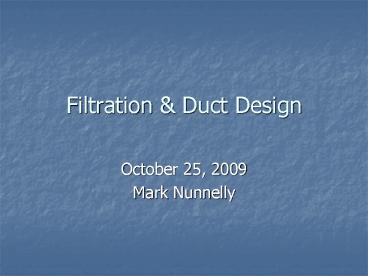Filtration - PowerPoint PPT Presentation
1 / 32
Title:
Filtration
Description:
FILTRATION Purposes of Filtration Keep AHU s system components clean (blower, motor and evaporator coils) Clean the air we breathe (dust, pollen, ... – PowerPoint PPT presentation
Number of Views:268
Avg rating:3.0/5.0
Title: Filtration
1
Filtration Duct Design
- October 25, 2009
- Mark Nunnelly
2
FILTRATION
3
Purposes of Filtration
- Keep AHUs system components clean (blower, motor
and evaporator coils) - Clean the air we breathe (dust, pollen, mold
spores, etc.) - Clean the air entering building environment for
improved building maintenance and longevity
4
Filtration Selection Considerations
- Efficiency requirements of project
- The types and dimensions of the particulates to
be filtered - Resistance to airflow
- Filter cost
- Physical size of the filter cabinet
- Location to permit service and replacement
5
Filtration Rating Criteria(ASHRAE Standard
55.2-1999)
- Arrestance (weight fraction of dust removed)
- Dust spot efficiency (ability of filter to reduce
soiling of fabrics and interior surfaces - Fractional efficiency (percent of uniformly sized
particles removed) - Particle size efficiency (percent of dust removed
with typical particle size distribution) - Dust holding capacity
6
Dirty Filters!
7
Dirty Filters!
8
Dirty filters increase friction loss and
therefore increase operating costs!
9
Friction loss can be minimized by these design
practices
- Reduce face velocity below common equipment
design velocity (i.e., 500 FPM) Downside
Increases equipment width as coil module size
increases (Formula 9.2, Page 129)
10
Friction loss can be minimized by these design
practices
- Choose pleated or bag filters as in figure 9.5 of
textbook Downside Higher cost filters,
increase depth of filters - Good practice is to include a differential
pressure gauge across the filter and/or install
an alarm of signal to alert the facility operator
of a need for a filter change.
11
(No Transcript)
12
(No Transcript)
13
(No Transcript)
14
Duct Design
15
Challenging Activity of Designing Ducts
- Find a balance between the conflicting
constraints of lowering the system installation
cost by reducing the duct size (supply and
return) with increasing air velocity, fan power
requirements, and noise levels. - The routing and sizing of supply and return
ducting (i.e., the air distribution system) is
one of the most challenging activities within the
design of the HVAC system.
16
Duct Design Methods(According to ASHRAE
Fundamentals Handbook)
- Equal Friction
- Static Regain
- T-Method Optimization
17
Equal Friction Method
- Simplest
- Most commonly used
- Therefore, this is the method well use in this
class
18
Equal Friction Method
- A maximum target friction loss per unit length is
selected and all ducts are sized to provide this
loss (or slightly less) - The conventional units are in inches of water
per 100 of straight duct. - Friction losses in fittings are expressed in
equivalent length of straight duct.
19
(No Transcript)
20
Duct Sizing example from Textbook
- Size a duct for a flow of 1000 cfm at a friction
loss of 0.1w.c./100 . Determine the actual
loss and velocity for the actual duct size.
21
Duct Sizing example from Textbook
- Size a duct for a flow of 1000 cfm at a friction
loss of 0.1w.c./100 . Determine the actual
loss and velocity for the actual duct size. - Solution The horizontal 0.1w.c./100 friction
line intersects the vertical 1000 cfm line at a
round duct diameter of 13.5. The next available
round duct size is 14. When this duct is used,
the loss will be 0.09w.c./100, and the velocity
is 950 fpm at this intersection. - Commonly used round duct sizes at
5,6,8,10,12,14,16 and 20
22
(No Transcript)
23
(No Transcript)
24
(No Transcript)
25
(No Transcript)
26
(No Transcript)
27
(No Transcript)
28
(No Transcript)
29
(No Transcript)
30
(No Transcript)
31
Fitting Losses K-factors
- More exact than using equivalent length method,
but more cumbersome - ?hK x (V2/2)
- K Geometry - and size-dependent loss
coefficient - V Average velocity, fps
- Text uses the simpler equivalent length method
32
(No Transcript)































